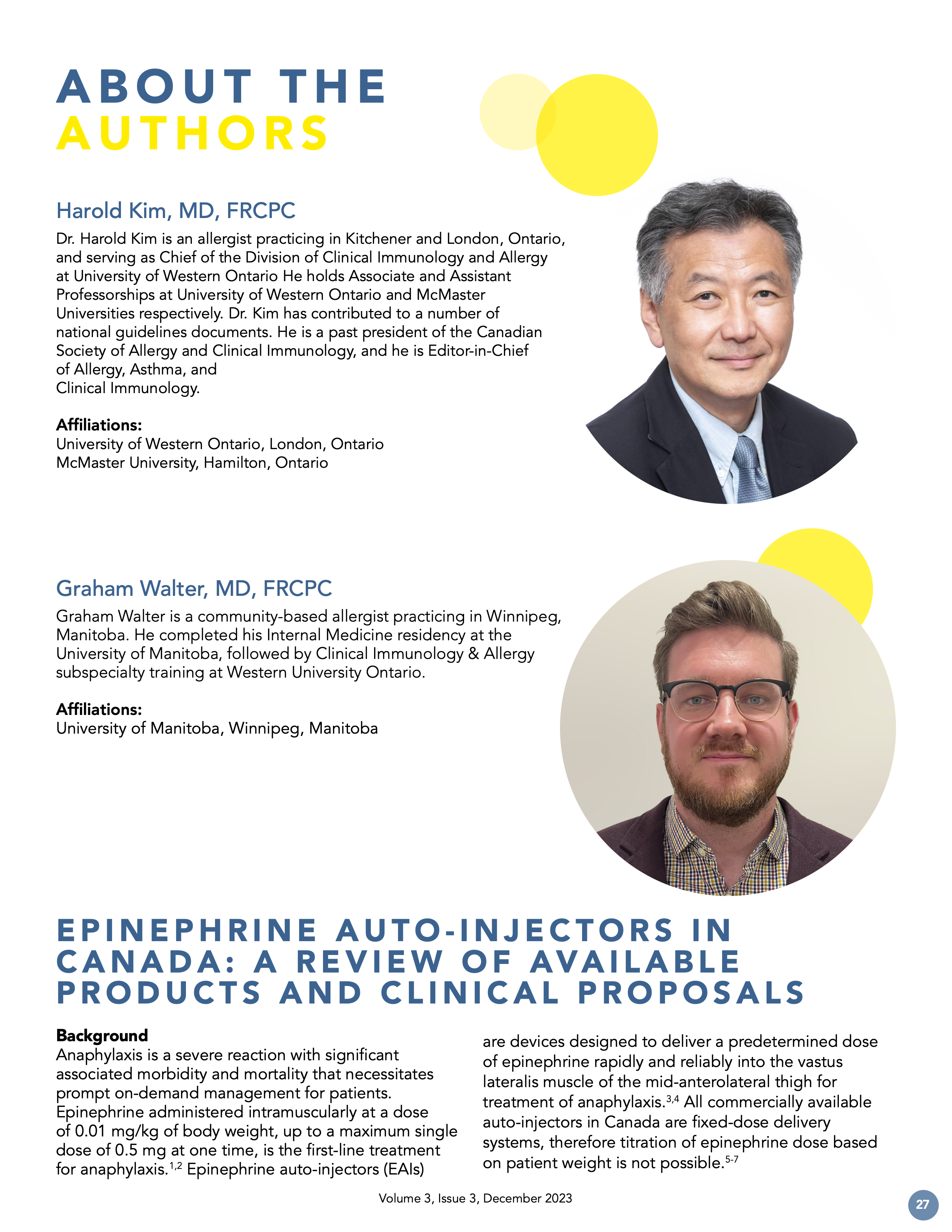Epinephrine auto-injectors in Canada: A review of available products and clinical proposals
DOI:
https://doi.org/10.58931/cait.2023.3359Abstract
Anaphylaxis is a severe reaction with significant associated morbidity and mortality that necessitates prompt on-demand management for patients. Epinephrine administered intramuscularly at a dose of 0.01 mg/kg of body weight, up to a maximum single dose of 0.5 mg at one time, is the first-line treatment for anaphylaxis. Epinephrine auto-injectors (EAIs) are devices designed to deliver a predetermined dose of epinephrine rapidly and reliably into the vastus lateralis muscle of the mid-anterolateral thigh for treatment of anaphylaxis. All commercially available auto-injectors in Canada are fixed-dose delivery systems, therefore titration of epinephrine dose based on patient weight is not possible.
In Canada, there are several manufacturers of EAIs, providing treating physicians and patients with a variety of options to treat anaphylaxis in the community. However, as these devices all contain the same medication, physicians may not realize that specific EAIs may be of greater utility in certain clinical circumstances. This scientific review aims to describe all currently available EAIs in Canada, with detailed discussion on the differences between products and the nuances of a patient-centred approach to prescription in a market filled with seemingly “one size fits all” devices.
References
Sampson HA, Muñoz-Furlong A, Campbell RL, Adkinson NF, Bock SA, Branum A, et al. Second symposium on the definition and management of anaphylaxis: Summary report - Second National Institute of Allergy and Infectious Disease/ Food Allergy and Anaphylaxis Network symposium. J Allergy Clin Immunol. 2006;117(2):391–7.
Shaker MS, Wallace D V., Golden DBK, Oppenheimer J, Bernstein JA, Campbell RL, et al. Anaphylaxis—a 2020 practice parameter update, systematic review, and Grading of Recommendations, Assessment, Development and Evaluation (GRADE) analysis. J Allergy Clin Immunol. 2020;145(4):1082–123.
Kim H, Alizadehfar R, Alqurashi W, Ellis AK, Fischer DA, Roberts H, et al. Epinephrine autoinjectors: individualizing device and dosage to optimize anaphylaxis management in the community setting. Allergy Asthma Proc. 2023;44(1):45–50.
Fischer D, Vander Leek TK, Ellis AK, Kim H. Anaphylaxis. Allergy, Asthma Clin Immunol. 2018;14(Suppl 2).
Mylan Specialty L.P. Prescribing Information EpiPen® [Internet]. 2017. p. 1–22. Available from: https://pdf.hres.ca/dpd_pm/00039519.PDF
Bausch Health CI. Emerade Prescribing Information [Internet]. 2020. Available from: https://www.emerade.ca/resources/assets/pdf/en/about/emerade-product-monograph.pdf
Kaleo Inc. Allerject Prescribing Information [Internet]. European Journal of Haematology. 2019. Available from: https://pdf.hres.ca/dpd_pm/00054258.PDF
Li LDX, Abrams EM, Lavine E, Hildebrand K, Mack DP. CSACI position statement: transition recommendations on existing epinephrine autoinjectors. Allergy Asthma Clin Immunol. 2021;17(1):1–6. DOI: https://doi.org/10.1186/s13223-021-00634-2
Dreborg S, Walter G, Kim H. International recommendations on epinephrine auto-injector doses often differ from standard weight-based guidance: a review and clinical proposals. Allergy Asthma Clin Immunol. 2022;18(1):1–11. DOI: https://doi.org/10.1186/s13223-022-00736-5
Song TT, Nelson MR, Chang JH, Engler RJM, Chowdhury BA. Adequacy of the epinephrine autoinjector needle length in delivering epinephrine to the intramuscular tissues. Ann Allergy Asthma Immunol. 2005;94(5):539–42. DOI: https://doi.org/10.1016/S1081-1206(10)61130-1
Kim H, Dinakar C, McInnis P, Rudin D, Benain X, Daley W, et al. Inadequacy of current pediatric epinephrine autoinjector needle length for use in infants and toddlers. Ann Allergy Asthma Immunol. 2017;118(6):719-725.e1. DOI: https://doi.org/10.1016/j.anai.2017.03.017
Sicherer SH, Simons FER, Mahr TA, Abramson SL, Dinakar C, Fleisher TA, et al. Epinephrine for first-aid management of anaphylaxis. Pediatrics. 2017;139(3).
Dreborg S, Kim H. The pharmacokinetics of epinephrine/adrenaline autoinjectors. Allergy Asthma Clin Immunol. 2021;17(1):1–11. DOI: https://doi.org/10.1186/s13223-021-00511-y
Patel N, Isaacs E, Duca B, Nagaratnam N, Donovan J, Fontanella S, et al. Optimal dose of adrenaline auto-injector for children and young people at risk of anaphylaxis: A phase IV randomized controlled crossover study. Allergy Eur J Allergy Clin Immunol. 2023;(January):1–10.
Jeimy S, Wong-Pack A, Veettil S, Kim H. Point-of-care ultrasonography in the allergy and immunology clinic. Ann Allergy Asthma Immunol. 2019;123(1):42–7. DOI: https://doi.org/10.1016/j.anai.2019.02.010
Prescribe Smart.
Mylan Specialty L.P. How EpiPen Works [Internet]. [cited 2023 Apr 27]. Available from: https://www.epipen.ca/how-epipen-works
Bausch Health CI. Emerade: Designed for Simplicity [Internet]. [cited 2023 Apr 27]. Available from: https://www.emerade.ca
Kaleo Inc. Why Allerject? [Internet]. [cited 2023 Apr 27]. Available from: https://www.allerject.ca/why-allerject.html#voice

